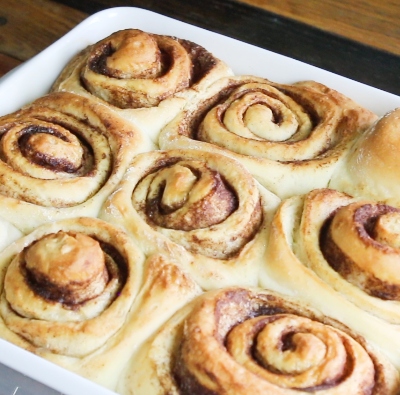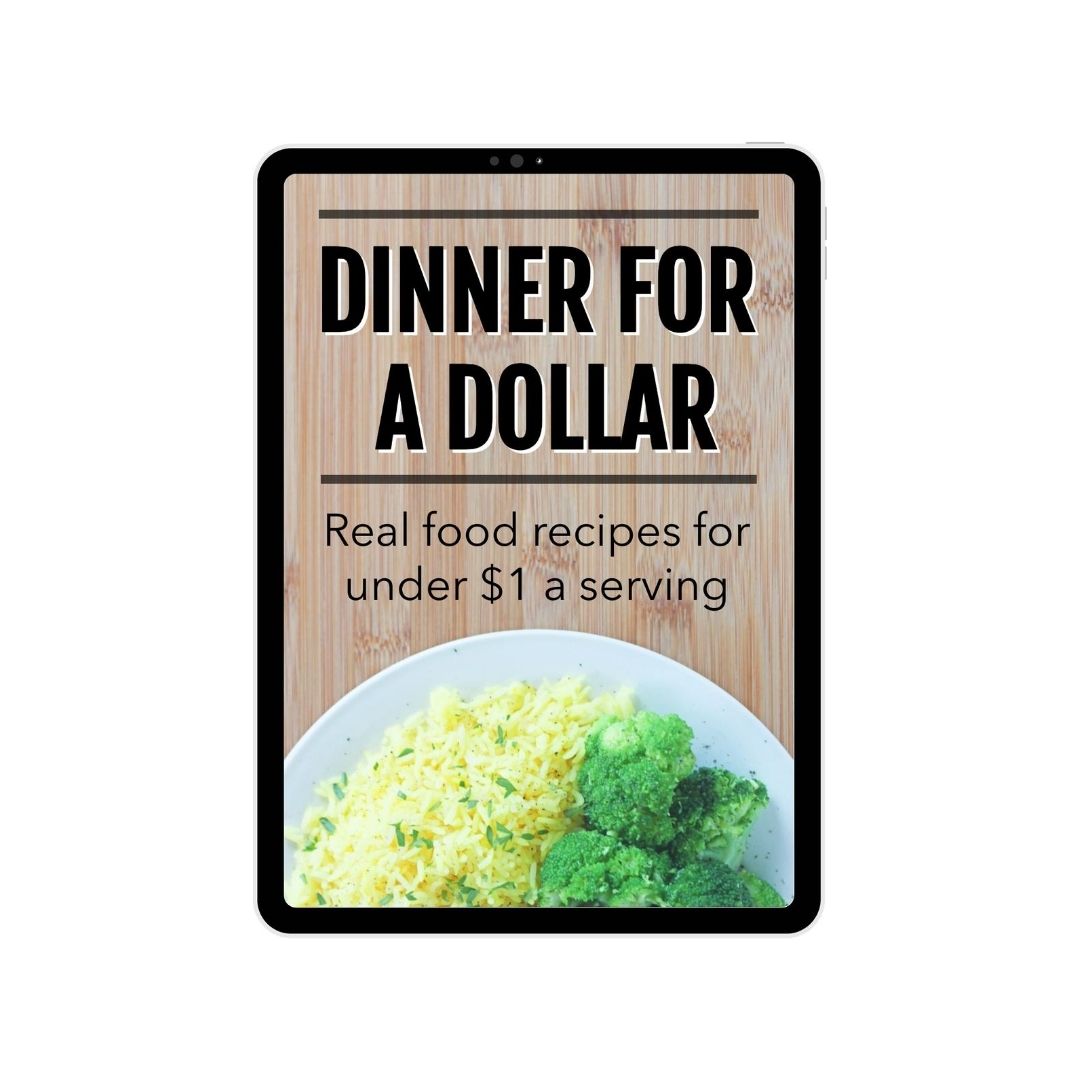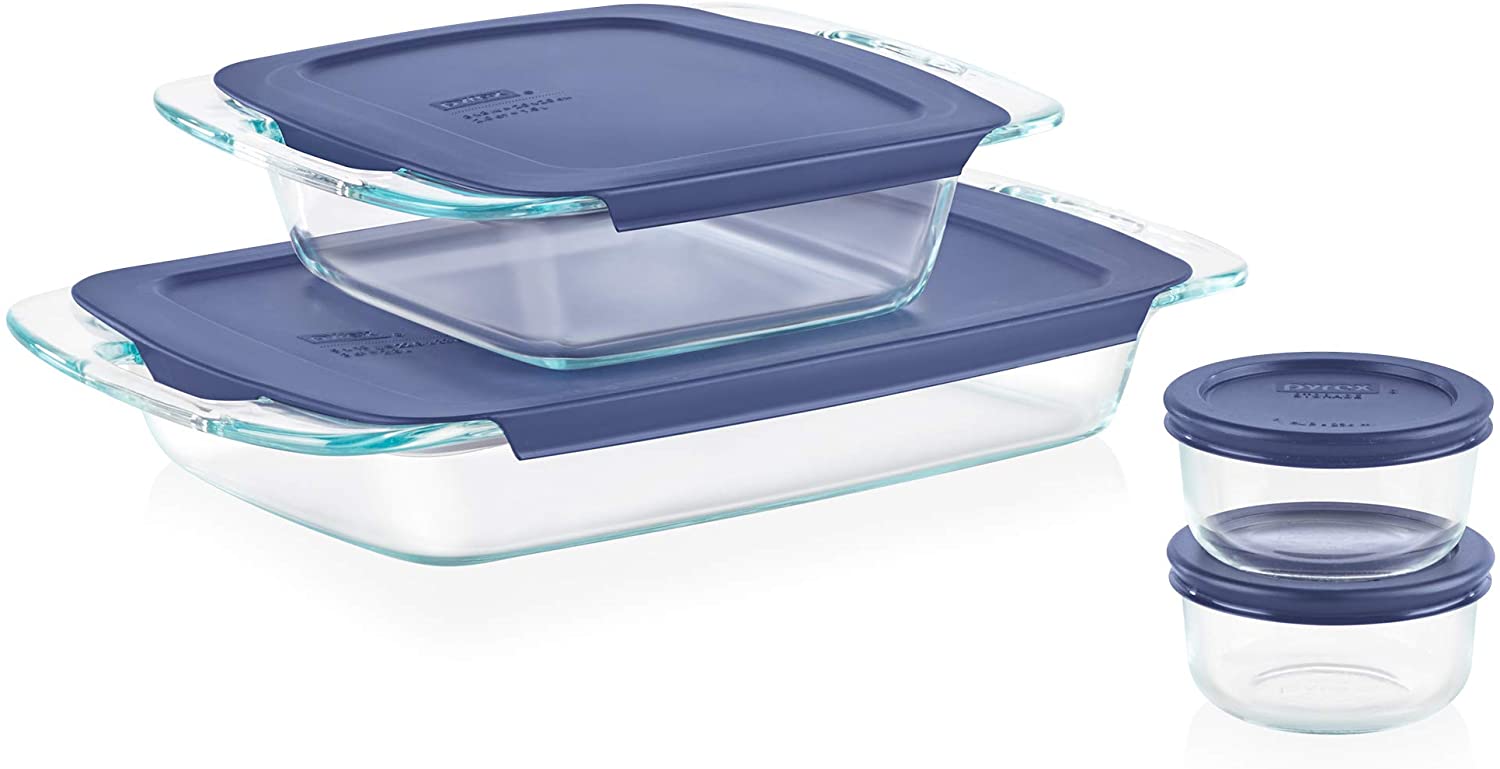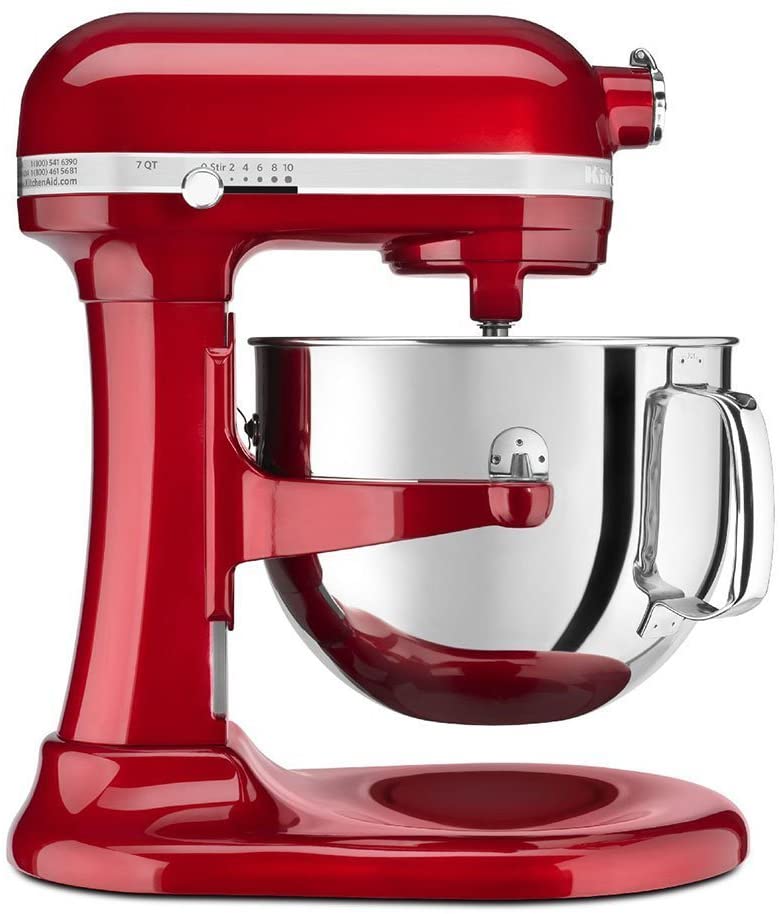Simple, homemade cinnamon rolls you can make in 2 hours or refrigerate overnight for fresh rolls in the morning!
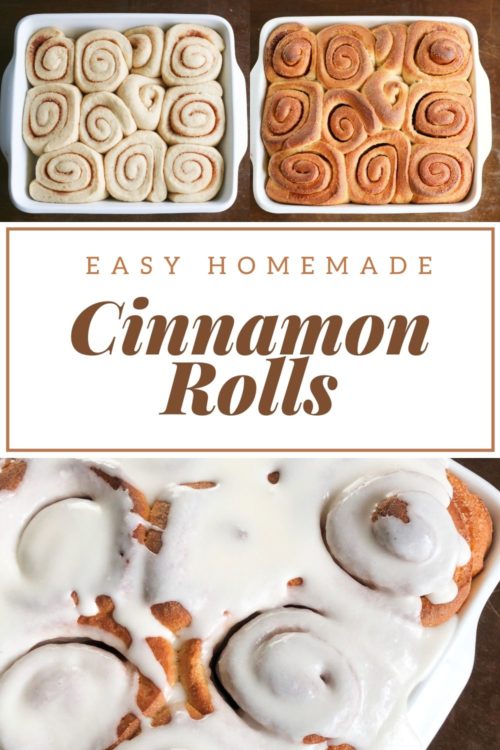
This post contains affiliate links. That means if you click on my link and buy something, I will earn a small commission from the advertiser at no additional cost to you. Read my disclosure policy here.
Cinnamon rolls are one of my favorite budget-friendly treats to make for my family. I mean yes, they seem so extra – homemade yeast bread and rising and punching, and rolling them out and don’t forget that powdered sugar glaze at the end.
But when you think about the ingredients that go into cinnamon rolls: flour, water (or milk), yeast, salt, butter, sugar, cinnamon. You’re looking at a fairly inexpensive treat.
Like homemade bread, it’s one of the most budget-friendly treats we can make that feel so special because so few people actually make them from scratch.
Cinnamon Rolls Recipe
To make my cinnamon rolls, I use my Master Bread Recipe. It’s simple, reliable, and inexpensive. You can tweak it a little to make the dough richer. Use milk instead of water and butter instead of oil. But it’s basically the same. And honestly, because I bake the Master Bread Recipe in double and triple batches, I typically don’t change the recipe at all. I just shape some of it into cinnamon rolls while the rest gets shaped into bread loaves (or dinner rolls or pizza crust).
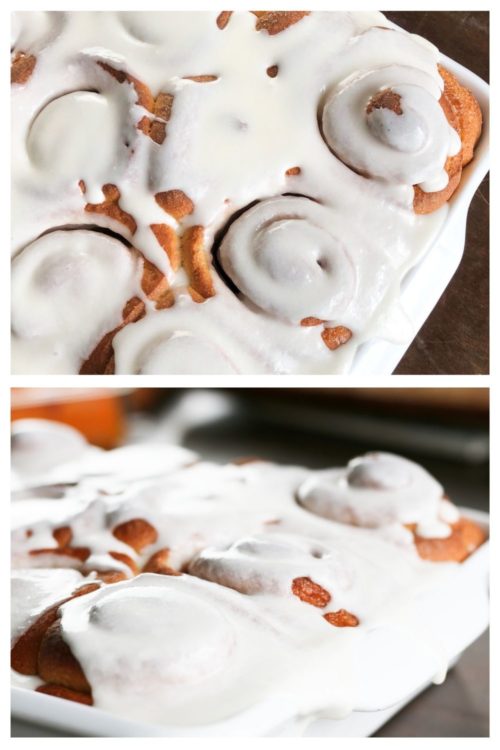
Easy Homemade Cinnamon Rolls
If your goal is to make easy cinnamon rolls, it can’t get much simpler than throwing in a batch while making something else. That’s why I love the Master Bread Recipe. You only need to get good at making one kind of yeast bread, but you can use it for all kinds of things – including these cinnamon rolls.
If you want the best and easiest cinnamon rolls, use all white flour. Let’s be honest – whole wheat is a contradiction to the whole concept of cinnamon rolls. That being said, I’ve totally done it before. They’re delicious and hearty in their own right. In fact, I feel more comfortable baking cinnamon rolls more often if they’re “healthier.” But then, if they’re healthier, are they even cinnamon rolls?
Homemade Cinnamon Rolls
The only difference between my regular homemade bread and cinnamon rolls is how I shape them at the end. Certainly, you can make truly amazing cinnamon rolls if you learn a specific recipe that’s made to be the very best cinnamon rolls you’re ever tasted.
But I’m not a bakery, I’m a home cook. And if my family wants cinnamon rolls, they’re going to have to be simple to make and simple to master.
Simple and DONE is better than complicated/fancy and intimidating.
How to Make Cinnamon Rolls Video
This is the video for my Master Bread Recipe, but it includes a tutorial on how to make the cinnamon rolls!
Ingredients for Homemade Cinnamon Rolls
The ingredients for homemade cinnamon rolls are simple and direct. But there are a few substitutions you can make to use what you have or get slightly different results.
Unbleached all-purpose flour
For classic cinnamon rolls, I use all unbleached all-purpose flour. You can use bleached flour if that’s what you have, but I think it tastes better with unbleached. If you want to make it healthier, use a little bit of whole wheat flour (or all whole wheat) but this will totally change the results – no more fluffy, squashy cinnamon rolls. Instead, it’ll be hearty brown bread rolls with cinnamon sugar and frosting.
That being said, I’ve totally done it before. They’re delicious and hearty in their own right, and I feel more comfortable baking cinnamon rolls more often if they’re “healthier.” But then, if they’re healthier, are they even cinnamon rolls?
Salt
Nothing exciting here. Just use whatever salt you have on hand.
Oil
For the dough, you can use oil or butter. Olive oil is a strong flavor you typically want to avoid in sweet baked goods. But for these cinnamon rolls, olive oil works just fine. Use what you have!
Honey
To sweeten the dough, you can use honey, maple syrup, or molasses, just like in the regular Master Bread recipe. However, if you’re planning to make cinnamon rolls and use sugar, feel free to use sugar for this step too.
Water
To make a richer dough, you can use warm milk instead of water. However, because I bake the Master Bread Recipe in double and triple batches, I typically don’t change the recipe at all. I just shape some of it into cinnamon rolls while the rest gets shaped into bread loaves (or dinner rolls or pizza crust).
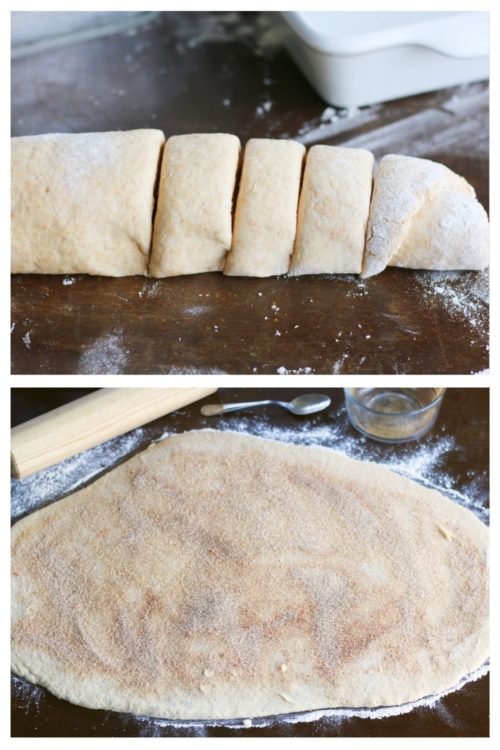
Yeast
What is the difference between Active Dry Yeast and Instant Yeast?
Both active dry yeast and instant yeast do the same thing in a loaf of bread – they both act as a leaven, which reacts with the ingredients in the bread and gives it a light, airy texture as it rises and bakes.
However, there is one big difference between active dry yeast and instant yeast that you need to know:
Active dry yeast should be dissolved in water before adding it to the flour. Instant yeast can be stirred right into the flour.
To save money, I usually buy yeast in a big cake from Costco. I store a few cups of it in a jar in the fridge, and the rest of it I store in the freezer. It lasts for years this way. In fact, I can’t even remember the last time I bought yeast.
I’ll share the active dry yeast instructions in the recipe, but I’ll also add instant yeast instructions in the notes.
Butter
When you form the actual cinnamon rolls, you’ll spread them with butter and the cinnamon-sugar mixture. Personally, I never measure the amount of butter I spread onto the rolls. Just make it nice and generous and yummy.
Cinnamon Sugar
You can use whatever kind of granulated sweetener you feel comfortable with – regular cane sugar, raw sugar, etc. Personally, I buy our sugar from Aldi or Walmart, and it’s an inexpensive fair trade, non-GMO brand called Zulka – Morena Pure Cane Sugar – just slightly better than regular sugar.
To make cinnamon sugar, you want to use the ratio of 1 tablespoon of sugar to 1 teaspoon of cinnamon. To make a batch of cinnamon rolls, I usually mix 1/4 cup sugar with 4 teaspoons of cinnamon.
Icing
To make the icing, you can use powdered sugar, milk, and vanilla. Simple and sweet. If you like cream cheese frosting and you want to shoot for something that’s naturally sweetened, try this maple syrup-sweetened cream cheese icing.
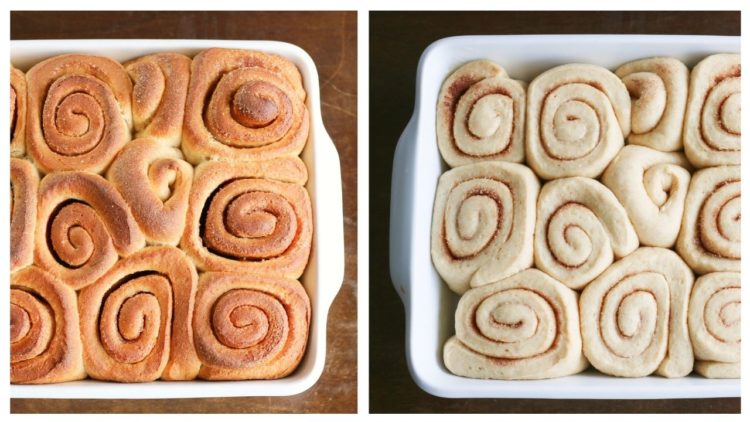
How to Make Homemade Cinnamon Rolls
To make the dough, follow the instructions from my Master Bread recipe. It’s pretty simple and straightforward:
Combine the flour and salt. Combine the liquids and yeast. When the yeast is bubbly, add the liquids to the dry ingredients and stir to combine. Then I use my Kitchen Aid Mixer to knead the bread dough until it is smooth and elastic. I grew up kneading bread dough by hand, so you can totally do that. It is actually very satisfying. Or you can Get a Bosch mixer, which is a more sturdy kneading mixer than the Kitchen Aid.
Let the dough rise twice for 30-40 minutes each. After the second rise, roll the dough out on a floured surface until it’s about 1/4-1/2 inch thick. Spread generously with butter, cinnamon, and sugar. Then roll it up (lengthwise = more buns but they’ll be smaller, widthwise = less buns, but they’ll be nice and thick), slice it gently with a sharp bread knife, and line it up in a greased pan.
Cover with a cloth and let them rise for 30 minutes. Bake at 350 F for 35-40 minutes.
When they cool, drizzle them with the icing.
Is it Okay to Let Cinnamon Rolls Rise Overnight?
If you want to bake the cinnamon rolls in the morning so they are fresh, simply cover them with plastic wrap (create a loose tent with the plastic wrap so it doesn’t stick the rolls and ruin the rise), and set them in the fridge overnight. Remove them from the fridge the next morning while the oven preheats. Then bake as usual.
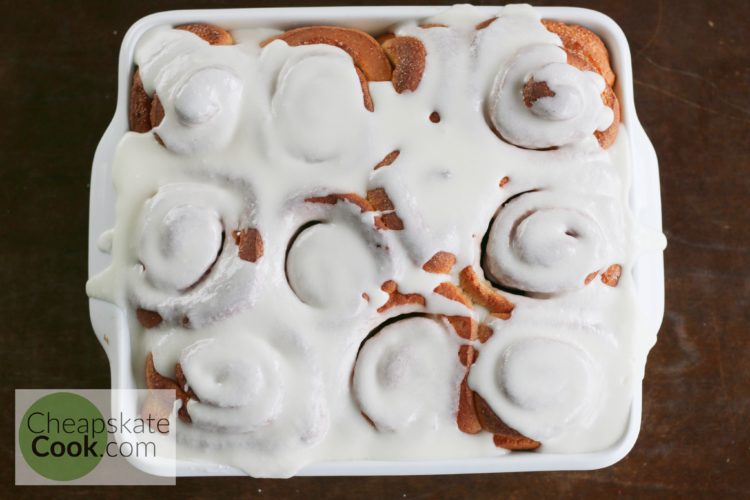
Do I Have to Use a Mixer to Knead Bread?
While using a Kitchen Aid or a Bosch Mixer to knead your bread dough is extremely helpful (I’ve had my giant-size Kitchen Aid for nearly 10 years, but I’m planning to get a Bosch if it ever dies), you can absolutely knead this bread by hand.
Kneading is something that is easier to understand when you see it, rather than read it, so I recommend hopping over to this video and seeing how to knead bread dough correctly!
I grew up baking all of our own bread, and we always kneaded it by hand. My arms were so toned and kneading bread is extremely soothing and therapeutic.
It’s therapy and carbs at the same time.
Don’t fear the hand-kneading.
That being said, I love having the option to NOT knead my bread now (thank you, KitchenAid), and my arm muscles certainly show it.
If you try this recipe, let us know! Leave a comment, rate it, and tag a photo #cheapskatecook and @cheapskatecook on Instagram.
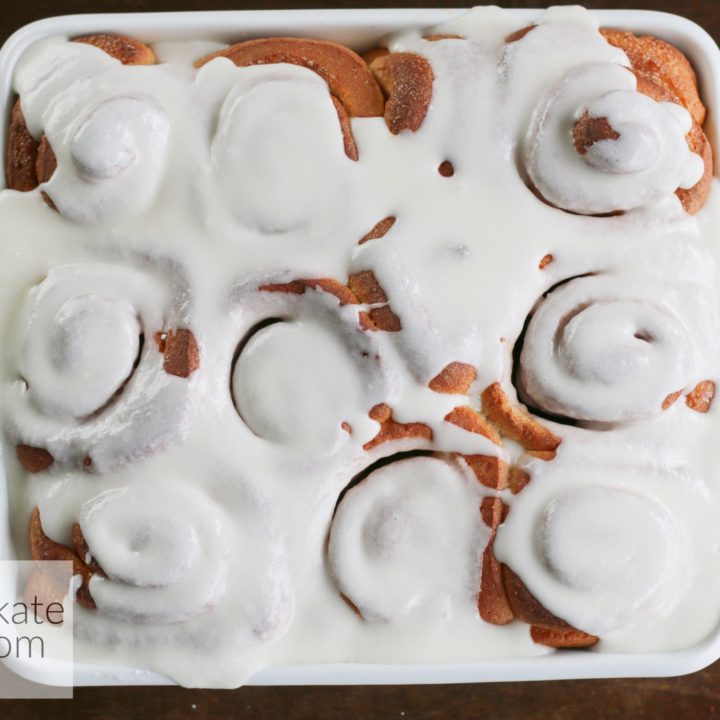
Cinnamon Rolls Recipe
Simple, homemade cinnamon rolls made with my master bread recipe!
Ingredients
- 2 1/2 cups warm water (should be no hotter or colder than your finger when you dip it in the water)
- 1/4 cup olive oil
- 2 tbsp sugar, molasses, honey, or maple syrup
- 1 tbsp dry active yeast
- 6 cups unbleached all-purpose flour
- 2 tsp salt
- 3-4 tbsp butter, softened
- 1/4 cup sugar
- 1 tbsp plus 1 tsp cinnamon
- For the Icing:
- 4 cups powdered sugar
- 1 tsp vanilla
- 1/3-1/2 cup milk
Instructions
In a large measuring cup or medium-size bowl - or, hey, even a plastic leftover container because you forgot to do the dishes and would rather make bread than clean the kitchen (this is a true story at my house) - stir together the water, oil, sugar, and yeast. Set it aside for 5-10 minutes, so the yeast can activate.
Meanwhile, in a large mixing bowl, stir together the flour and salt. Nothing exciting happening here.
However, there should be something very exciting happening in the yeast and water mixture. After 5-10 minutes, the surface of the water should look like a boggy, swamp that is definitely possessed by a swamp demon. It'll be bubbly, frothy, and might have even started to rise a little. Fear not. You have the silver cross for this swamp demon.
It's called pouring the water mixture into the flour mixture and stir until a raggy, messy dough kind of comes together. It won't be pretty, but it should smell like bread.
If you have a mixer with a kneading attachment (Kitchen Aid or Bosch are nice), use that to knead the dough for 5-10 minutes. During the kneading process, you might need to add a few tablespoons of water or flour if the dough is overly dry or wet. Only add a tablespoon of either ingredient at a time in order to avoid a cereal and milk, then more cereal to use up the milk, then more milk because the cereal is too dry, situation.
If you're like my family when I was growing up and you like massive forearms, knead the dough by hand. This is easier seen than explained, so do a quick internet search and start making everyone jealous of your toned arms.
I demonstrated in the video what the dough should look like when you're done kneading. Basically, if you gently press your finger against it, the dough should spring back until your fingerprint is mostly gone.
Smooth the surface of the bread by tucking the edges underneath it until the surface is smooth and dough forms a nice ball. Place it back in the bowl (you can grease the bowl with a little olive oil if you like), cover it with a towel, and let it rise for 30-40 minutes.
It won't rise very high the first time. Punch it down, cover the bowl, and let it rise another 30-40 minutes.
After the second rise, use a rolling pin to roll the dough out on a floured surface until it's about 1/4-1/2 inch thick. In a small bowl, stir together the sugar and cinnamon. Generously spread the dough with butter, then sprinkle with cinnamon sugar. Then roll it up (lengthwise = more buns but they'll be smaller, widthwise = less buns, but they'll be nice and thick), slice it gently with a sharp bread knife, and line it up in a greased pan. For a visual tutorial, watch the video!
Cover and rise for 15 minutes. Preheat the oven to 350 F and let it rise for another 15-20 minutes.
Bake for 30 minutes, until the top of the rolls are golden brown.
Let the rolls cool for 45 minutes. While they are cooling, combine the powdered sugar, vanilla, and milk in a large bowl. Start with 1/3 cup milk and if needed add more milk 1 tbsp at a time until the icing reaches the desired consistency. When the rolls are fairly cool to the touch, top generously with the icing and serve.
Notes
Bake Cinnamon Rolls Fresh in the Morning
If you want to bake the cinnamon rolls in the morning so they are fresh, simply cover them with plastic wrap (create a loose tent with the plastic wrap so it doesn't stick the rolls and ruin the rise), and set them in the fridge overnight. Remove them from the fridge the next morning while the oven preheats. Then bake as usual.
Naturally-Sweetened Icing
If you like cream cheese frosting and you want to shoot for something that's naturally sweetened, try this maple syrup-sweetened cream cheese icing.
Instant Yeast
If you're using instant yeast, simply stir the yeast in with the flour and salt, then pour the liquids into the flour mixture.
Recommended Products
As an Amazon Associate and member of other affiliate programs, I earn from qualifying purchases.
Nutrition Information
Yield 16 Serving Size 1Amount Per Serving Calories 480Total Fat 13gSaturated Fat 6gTrans Fat 0gUnsaturated Fat 6gCholesterol 24mgSodium 377mgCarbohydrates 87gFiber 2gSugar 50gProtein 6g
Please note: The actual calories and nutrition of this dish will change depending on what ingredients you use. Nutrition information is not always accurate.
More Breakfast Recipes Like This:
- Cinnamon Roll French Toast
- Chocolate Chip Muffin Tops
- The Only Pancakes Recipe You Need
- Our Favorite Baked Oatmeal
What You Can Do Now:
Make some cinnamon rolls! Set aside two hours one weekend and try this recipe! If it fails (old yeast, cold weather, newbie mistakes – we all have failed loaves sometimes), make some pizza crust instead (or just forge ahead. It’s cinnamon rolls – it won’t be bad)! You can’t lose with this recipe.
If you found this recipe helpful, let us know! Leave a comment, share it on Facebook or Pinterest, and follow us on Instagram or YouTube for more!
Slash your grocery budget and feed your family real food! Get simple, frugal, real food menu plans every month for FREE in the Cheapskate Cooks’ 1-Min Email. Get the next one here.

